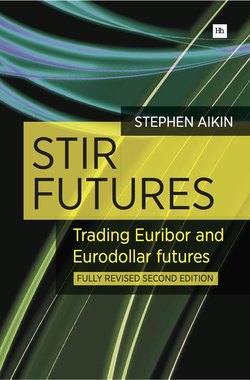Читать книгу STIR Futures - Stephen Aikin - Страница 5
На сайте Литреса книга снята с продажи.
ОглавлениеIntroduction
Most people are only aware of interest rate changes when they make the newspaper or television headlines, but interest rates are moving all the time. They are driven by the supply and demand of money being borrowed and lent in the money markets. STIR futures are one of the key financial derivatives in this market.
STIR futures first appeared in the 1980s as the Eurodollar contract, based on US interest rate deposits traded on the Chicago Mercantile Exchange (CME). CME’s success encouraged European emulation, resulting in the formation of the London International Financial Futures Exchange (now NYSE Liffe but referred to as Liffe in the text) in the early eighties and the creation of the Short Sterling (UK rates), Euromark (German rates), Euroswiss (Swiss rates) and Eurolira (Italian rates) STIR futures.
All futures were then traded by a method called open outcry. This involved the shouting out of order flow into a circular pit populated by traders wearing the colourful jackets of their company’s livery. Nowadays, almost all trading is computerised, creating a global virtual trading pit with no restriction on the number of participants it can hold. Consequently, STIR futures volumes have exploded in recent years. Arguably they are now the largest financial market in the world. It is not unusual for the leading STIR futures contracts, the Eurodollar and Euribor, to each trade over two trillion dollars’ or euros’ worth of interest rate transactions every day. Compare that with the $150 billion traded on a good day at the New York Stock Exchange, or even with the entire foreign exchange market, which trades approximately $3-trillion-worth per day, and it gives a clear idea of just how large the STIR futures markets are.
However, STIR futures are unique amongst financial markets in that individual traders can compete and trade on equal terms with other participants such as banks and large funds. It is a completely level playing field – unlike other markets, remaining free from domination by middlemen and market makers. Today’s fully computerised STIR futures markets support a global network of professional individual traders who benefit from the unique characteristics of these markets. Traders are not restricted to using a broker’s service or trading platform but can directly buy and sell into the central marketplace with similar technology and market information as the largest players.
Futures are often perceived as being highly risky trading instruments. This is not helped by the rogue trader scandals of the likes of Leeson, Kerviel and Adoboli, who between them lost $10 billion fraudulently trading futures. Futures have also made it to the silver screen; Hollywood has glamorised futures trading in films like Trading Places and Rogue Trader. On celluloid, futures trading is highly speculative and an easy route to bankruptcy.
Admittedly, futures can be extremely risky instruments, especially if over-leveraged, but they are a broad class. It is unfair to categorise all futures as having the same risk profile. STIR futures are lower risk than most other types of futures contract and they can provide a lower trading risk profile than shares, currencies or spread betting. They do this by providing consistent returns from a diverse range of low-risk strategies not available in any other financial market.
Recent years have seen a growing number of individuals trading STIR futures for their own account, attracted by the professional direct market access and level terms of competition. Some traders have been very successful. Many more are content with an attractive and flexible lifestyle. Of course, some aspiring traders have discovered that a life in the markets is not for them. But the vast majority of people who leave it behind do so as a personal decision and not because of outlandish losses to be read about in the media.
Hopefully, this book will provide you with the knowledge to trade STIR futures intelligently, allowing you to make your own informed decision about this unique market and financial instrument.
STIR Futures – Quick Summary
1 STIR futures comprise one of the largest financial markets in the world. The two largest STIR futures contracts, the Eurodollar and Euribor, regularly trade in excess of one trillion dollars and euros each day.
2 The STIR futures markets are fully computerised, allowing easy global access.
3 Professional STIR future traders need a minimum capital of approximately £25,000 to start trading their own account, though sometimes nothing is required to join a trading arcade’s proprietary trading scheme.
4 STIR futures are one of the lowest-risk financial futures contracts and trading spreads or similar strategies provides an even lower risk profile. Trading STIR futures can provide more frequent and consistent returns with lower risk than most other kinds of financial product.
5 STIR futures are essentially financial building blocks. This makes them very suitable for trading against each other or other interest-rate contracts. The sheer number of trading permutations offered by their range of contracts and spreads allow traders to find their own professional niche.
